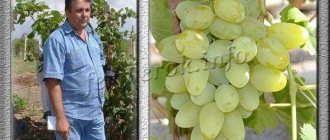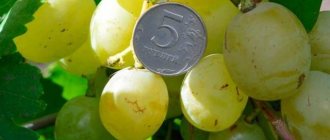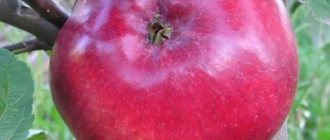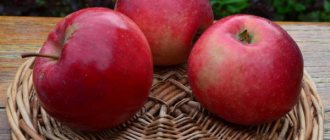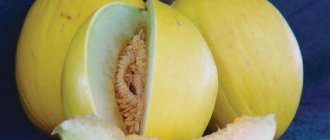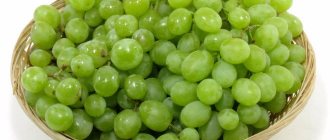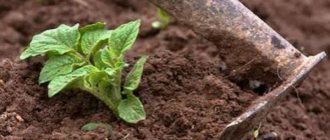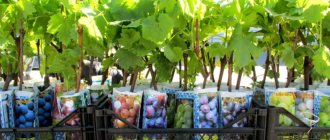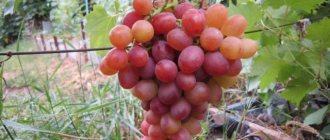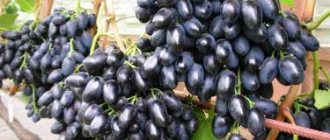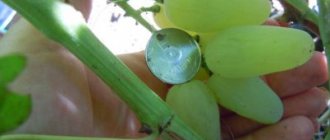Advantages and disadvantages
The main advantages of the variety are as follows:
- High yield (yield from one bush can reach 10 kg).
- Rich honey-floral taste of the fruit.
- Good frost resistance (down to -25°C).
- Easy to care for.
- Resistant to major common diseases and pests (2 insecticide treatments per season are sufficient).
The variety also has its disadvantages:
- Afraid of drafts and sudden temperature changes.
- It is necessary to regulate the load, otherwise the fruits will be small and tasteless.
- Not everyone likes the thick skin of the berries.
Advantages and disadvantages
Like any other variety, Dozen has its advantages and disadvantages. Of course, calling them that is not entirely correct - after all, what is an absolute advantage for private cultivation is a serious disadvantage for industrial production. Therefore, I believe that it is more correct to call such moments features, so let’s look at the features of the Dozen variety:
- Early ripeness - from the appearance of the first buds on the vine to the harvesting of a ripe harvest, it takes about 4 months or 125 days;
- Excellent frost resistance - few varieties can boast of such frost resistance as this one - it overwinters perfectly even at fairly low temperatures and even without shelter overwinters at temperatures down to -30.
- The result of the painstaking work of breeders is that plants are practically not susceptible to popular “grape” diseases and rarely get sick. True, it’s still impossible without treatment - I recommend taking any gentle broad-spectrum products a couple of times a season and spraying the vines. Two treatments will be enough - there will be no problems with Dozen.
- The vines themselves are strong and powerful. The vine reaches several meters in growth, while it is powerful and strong and does not break from the wind.
- The vine is densely covered with buds, most of them female.
- Around the beginning of June, the plants begin to bloom - it looks quite beautiful.
Origin
Reference! The breeding number of the hybrid is 13, hence the name “dozen”.
The variety was bred in 2007 by Luhansk breeder Alexander Ivanovich Kitaychenko, by crossing the varieties “Red Delight” and “Rizamat” (plus a mixture of pollen from different varieties).
Parents of the “dozen” – “red delight” and “rizamat”
Main characteristics
According to its characteristics, the hybrid variety “dozen” is suitable for growing both in small summer cottages and on industrial plantations.
Ripening period
In terms of ripening time, the variety is classified as early ripening; on average, 115-120 days pass from the awakening of the first buds to the ripening of the harvest. In the middle climate zone, the fruits ripen in the second half of August.
Bush
The bush grows up to 4 m in height, the root system is powerful and branched. You can form a bush according to any convenient pattern, but the main thing is to prune it in a timely manner and provide good support.
Bunches and berries
The clusters are large, weighing 500-1500g. They have a conical shape. The density of the berries is average.
The berries are large, round in shape, less often oval. The weight of one grape is 15-20 g, and the diameter reaches 3 cm. The color of fully ripe grapes is dark pink with a lilac tint. The pulp is juicy, medium density. There are 2-3 seeds in the center of the berry. The peel is dense, but you can’t feel it when eating.
Taste
Important! Grapes acquire a special rich taste only when grown in an open, sunny place.
The taste of the berries is harmonious, sweet, without the aftertaste of nutmeg.
Description of the Dozen grapes
From the beginning of the growing season to harvest, 120–130 days pass; in the middle zone, the berries ripen closer to the second half of August. The variety is rarely affected by diseases typical of the culture; illnesses can only appear in epidemic years. The berries are practically not damaged by wasps and sparrows. Frost resistance is up to 23 degrees, and in snowy winters it increases to 25.
Attention! The breeding number of the hybrid was 13, hence the name “Dozen”.
Characteristics of the bush and berries
The height of an adult bush is about 4 meters, the shoots are strong and ripen well during the growing season. The root is powerful, branched, the rooting of cuttings is excellent. A dozen begin to bear fruit in the second or third year after planting. On fruit vines, 3-4 clusters are formed, the bush can hardly withstand such a load, normalization is required. It is advisable to leave no more than 2 bunches on each branch.
The flowers are functionally female, and pollination is very good, stable without planting auxiliary varieties. The clusters are conical or cylindrical-conical, broad-shouldered, from 500 grams to two kilograms or more, the density of the cluster is average. The berries are oval or round, sometimes slightly flattened, from 12 to 20 grams. The color is very rich and bright, crimson-red with a lilac tint and a fairly dense waxy coating.
The flesh is crispy, juicy, the skin is dense, you can feel it when eating, but it doesn’t interfere. There are 4 seed chambers, berries with two seeds are often found, the grains are medium in size. The taste is rich, rich, balanced honey-floral, there is no nutmeg in the taste or aroma. The unique taste of Dozen grapes appears only when grown in an open, sunny place.
Yield and use
With proper formation of the bush, an adult plant produces up to 100 kg of harvest in one season; many gardeners share large figures. However, there are also those whose bushes begin to bear fruit only at the age of 4 or 5, while the signal clusters are small. The problem lies in non-compliance with the rules of agricultural technology, and not in the hybrid itself. Most often, the variety is grown for fresh consumption; the berries are suitable for making desserts. The fruits are often used to make juices, jams and various assorted fruits and berries.
Advantages and disadvantages
The variety is endowed with very good characteristics, which have been tested and confirmed by winegrowers from Ukraine, Russia, Moldova and Belarus. Problems during cultivation arise only in regions with cold and short summers, as well as in areas where winters are predominantly snowless. Hybrid features:
- great vigor of bush growth;
- good ripening of the vines;
- productivity;
- frost resistance;
- resistance to diseases and pests;
- high marketability of brushes and berries;
- When fully ripe, the fruits do not crack and practically do not fall off;
- good pollination;
- no peas;
- transportability and keeping quality (up to 2 months);
- Dozen cuttings have a high survival rate.
Attention!
The bushes produce a large number of stepchildren, on which full-fledged brushes are formed; they ripen later (closer to mid-September).
It is impossible not to note another advantage of the Dozen grapes - the bush can be planted in any convenient way, it is not necessary to prepare a large hole or fill it with a nutrient mixture. When planting using a simplified method (in a regular hole to the size of the seedling’s rhizome), fertilizing will have to be done from the very first year, and when planting in a prepared hole, fertilizer can be applied after the start of fruiting.
Features of cultivation
Growing a dozen grapes does not cause any particular difficulties even for novice gardeners. “Dozen” can be propagated both by seedlings and cuttings.
Seedlings are planted in prepared soil and must be tied up. At the end of the first summer, only the tops of the shoots are cut off. From the second year of growing season, annual autumn pruning of 6-8 buds is carried out. And in the spring, the bush is normalized: excess shoots and inflorescences are removed (one bunch is left on each shoot).
The variety is resistant to such common diseases as mildew, gray rot, and oidium. It is almost not susceptible to pests and destruction by wasps or sparrows.
In the first year after planting, the grapes need to be covered with film for the winter; this is a mandatory requirement even for the southern regions. In the future, after the start of fruiting, in the central and southern regions there is no need to cover the grapes for the winter; the variety can withstand temperatures down to -25°C. If the winter is snowless, then the frost resistance of the variety will be slightly lower, down to -23°C.
Important! Experts recommend carrying out preventive spraying against fungi twice a year: in the spring before flowering and in the fall after harvesting.
Thanks to the dense peel, the grapes are well transported and stored for a long time, having a marketable appearance. Suitable for fresh consumption and for making juices, tinctures, and wines.
It is grown in the southern, central and northern regions of Russia, including the Moscow region.
Maintenance work
A dozen are fairly unpretentious varieties and do not require complex care, especially if planting was done correctly. Care comes down to infrequent watering and loosening, several feedings and mandatory normalization of the bush. Like any grape vine, the Dozen bush also needs to be tied to a support.
Watering
For watering, a shallow trench is made around the bush (20 cm deep, 30 cm away from the seedling). The first month after planting, the bushes are watered once a week. Then they focus on weather conditions, preventing the soil from becoming swampy. If the bush was planted in the fall and the amount of precipitation was sufficient, then water-recharging watering for the winter is not needed. After a winter with little snow, spring water-recharging irrigation is carried out through the trench and drainage holes.
Important! Only warm water is used for irrigation. Watering from a hose is not permitted. All watering is done in the evening.
During the growing season, the bushes are watered several times:
- during the period of awakening of the kidneys;
- after flowering;
- while pouring berries.
In the second half of August, the plant stops watering for better ripening. In total, during the growing season, the vineyard consumes 450–500 liters of water per 1 m².
Top dressing
If the grapes are grown in a fertile area and all the necessary fertilizers were applied during planting, fertilizing is not necessary for the next 3 years.
In the future, you need to apply fertilizer according to the following scheme:
- Organic fertilizers (peat, rotted manure, wood ash). They are introduced in late autumn.
- Phosphorus-potassium fertilizing in the spring (20 g of superphosphate with 5 g of potassium salt and 10 g of ammonium nitrate per bucket of water. 10 liters of this fertilizer is poured under each bush).
- Spraying the bush with a solution of boric acid (5 g per bucket of water) before flowering begins.
- Before the formation of ovaries, use Kalimag fertilizer (10 g) and ammonium nitrate (20 g), diluted in 10 liters of water.
- 10–20 days before harvest, to improve taste, add 20 g of superphosphate and 20 g of any potassium fertilizer (without chlorine), diluted in 10 liters of water.
Find out more about how to properly feed grapes in the fall.
Soil care
Soil treatment includes the following activities:
- Deep digging in the fall with a continuous pass using a bayonet shovel.
- Spring treatment after thawing (destruction of the soil crust and closing off moisture using a flat cutter or hoe).
- Leveling and digging up the earth without turning the layer after opening the bushes.
- Summer loosening with a fork 5–10 cm after each rain to retain moisture and remove small weeds.
- If there are a large number of weeds, weeding is done manually.
To reduce the time and effort spent on weeding, as well as to preserve moisture, the soil is mulched (covered with a 5–10 cm layer of various materials, from straw to polymer films).
Mulching is carried out in the spring (after the soil has warmed up well) and in the fall, before wintering. Did you know? When cultivating grapes in arid climates, they are mulched with large stones in the summer. They heat up slowly, and when they encounter heated air, dew forms on the stones, providing so-called dry watering.
Support
In the first year, the seedling is tied to a vertical support. In the spring of the second year, the shoots are placed on a two-plane trellis at an angle of 45°. To create such a trellis, two vertical supports 2 m high are placed, brought together at the base and diverging upward. The supports can be made from durable wood (oak, poplar, acacia) or iron pipes with a diameter of at least 3 cm.
2–4 tiers of wire are attached to the supports, to tension which transverse strips are installed (the lower one is 15–20 cm long at a height of 40–50 cm above the ground, the upper one about a meter long is at the very top of the support). This method of placement promotes good sunlight and ventilation of the bushes.
Tying up shoots
The shoots are carefully bent and tied to the wire by hand using fabric strips. In addition to this ancient method, you can also use a tool called a tapener, which will significantly speed up the process. This mechanical garter wraps the plant and support with special tape, secures the garter with a staple, and trims the tape.
Comparison with analogues
If we compare the “dozen” with similar table varieties of pink grapes, then in terms of yield and berry size it can be compared with the “original” and “pink haze” varieties. But the “original” is a medium-late variety in terms of ripening and at the same time has average frost resistance, therefore it is suitable for cultivation only in the southern and some central regions. And “pink haze,” for all its advantages, has a very sweet taste of berries with delicate skin, which makes them attractive to wasps and other pests.
Let's sort it out in more detail in a comparative table with several more similar varieties.
| Sign | Variety | |||
| Dozen | Original | Sensation | Rumba | |
| Ripening period | 100-110 days | 120-130 days | 100-110 days | 110-115 days |
| Frost resistance | Up to -25 °C | Up to -24 °C | Up to -25 °C | Up to -24 °C |
| Yield per bush | up to 80 kg | up to 100 kg | 60-80 kg | 50-60 kg |
| Bunches | 500-1500 g | 500-800 g | From 700 g to 1.5 kg | From 800 g to 1.2 kg |
| Taste | Honey-floral | Harmonious | Taste of nutmeg | With notes of cherry |
| Color | Crimson | Green-yellow | Yellow-pink with crimson | Amber pink |
| Disease resistance | High | Average | High | High |
| Shelf life | Few weeks | Few weeks | 4-6 months | Up to 6 months |
| Sugar content | 16-19% | 15-21% | 18% | 18-20% |
| Acidity | 5-9 g/l | 6-8 g/l | 4-5 g/l | 5-7 g/l |
Diseases and pests
Diseases
According to the description, the Dozen grape variety is resistant to the most common diseases:
That is why the plant does not need multiple treatments. But this does not exclude spraying according to the schedule: in the spring before the vine begins to bloom and in the fall after the vine sheds its leaves. In the spring they are treated with boric acid, and in the fall with Bordeaux mixture. In years when spring is characterized by an abundance of cloudy days and rain, a week after spraying with boric acid, Bordeaux mixture or Fitosporin solution is sprayed.
Photo
Below, check out the photo of the variety and leave a review about it.
What diseases is the variety susceptible to, effective preventive measures
The best prevention is proper planting, timely pruning and all the necessary work. A healthy, strong plant will protect itself from pests.
However, preventative treatments are still necessary:
- the first is carried out in the spring, when the air temperature warms up to 4-6 degrees, the bushes are sprayed with a 1-3 percent solution of iron sulfate;
- from fungal diseases, after opening the eyes;
- if necessary, you can re-treat 1-2 weeks before flowering.
- the next one, for fungal diseases, is carried out in the summer, after the period of flowering and berry setting;
- in the fall, before sheltering, the vines, as well as the soil next to the plants, are sprayed with fungicides.
Dozen has good resistance to major diseases - mildew, oidium, gray rot - at the level of three points. The berries are practically not damaged by wasps.
Let's watch a useful video about grape diseases, their treatment and prevention:
Reviews
“Very large and tasty berries. After eating, the taste of flower honey is felt in the mouth. In Volgograd it ripens around mid-August.” Anna, Volgograd
“The variety is really unpretentious, grows very quickly, and does not require any special care. Only normalization must be done, otherwise the berries will be small.” Mikhail, Krasnodar region
“We planted a dozen on the plot, especially for fresh eating. Excellent variety! We tried the first harvest the following year.” Dmitry, Moscow region.
“I’ve been growing Dozen for 5 years now, there have been no diseases, I treat the bushes 2 times a year. In the fall I feed it with ash.” Anatoly, Rostov-on-Don
Thanks to its characteristics, the “dozen” variety is universal for both beginning gardeners and experienced winemakers; it is suitable for cultivation on both a small and industrial scale.
Reproduction and planting
Seedlings and cuttings are the 2 main methods of propagating this variety. Propagation by cuttings occurs by grafting or directly planting in the ground. If planted in the ground, the cutting must first be placed in a solution for roots to grow. If you are grafting, you need to select a strong grape stem and cut it, leaving 15 cm, then split it and place the cutting there and secure it with ropes. However, this method entails a difference in the characteristics of the plant from the expected ones.
If you plant a seedling, it is important to choose a lighted place without drafts to avoid drying out and becoming infected with diseases.
The hole dug for the seedling should be 80 cm in diameter and 80 cm deep. The bottom of the hole is filled with crushed stone, after which soil mixed with compost is added. The seedling is immersed in this mixture and covered with soil. The seedling should be held by some stick or other support, then watering is carried out. After a couple of days, mulch the soil.
